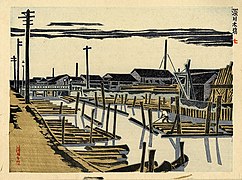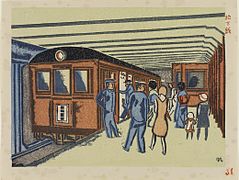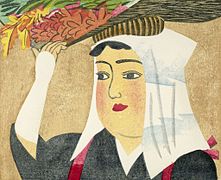Maekawa Sempan
Maekawa Sempan ( Japanese 前 川 千 帆 ; October 5, 1888 in Kyoto - November 17, 1960 , real name Ishida Shigesaburō ( 石田 重 三郎 )) was a Japanese woodblock print artist of the Sōsaku-hanga direction.
life and work
Born as the son of Ishida Masashichi, Shigesaburō was adopted by his mother's family after the death of his father in 1904 and was named Maekawa. In the same year he began to study Western painting at Kansai bijutsu-in ( Kansai Art Academy ) under Asai Chū and Kanokogi Takeshirō . In 1912 he went to Tokyo and worked for Kitazawa Rakuten's satirical magazine Tōkyō Puck ( 東京 パ ッ ク , Tōkyō Pakku ) and began to draw manga . In 1915 he went to Seoul and worked for a newspaper there, but returned after two years and worked as a journalist for Yomiuri Shimbun and Kokumin Shimbun.
In 1818 Maekawa was involved in the establishment of the "Japanese Association for Creative Woodcut" ( 日本 創作 版画 協会 , Nihon sōsaku hanga kyōkai ) and was represented in 1919 at the first and then at the second and fourth exhibition of the company with prints. In 1931 he was involved in the establishment of the broader "Japanese Association for Woodcut" ( 日本 版画 協会 , Nihon hanga kyōkai ). Maekawa also exhibited at the Teiten Academy of Arts and at the exhibitions of the Shun'yō-kai ( 春陽 会 ) artists' association . In 1936 he took part in the art competition on the occasion of the Olympic Games in Berlin with the work "Long Jump". However, his contribution was not awarded.
After the Second World War he continued to exhibit , but withdrew from the Japanese Association for Woodblock Printing , instead participating in the founding of the Nippan-kai ( 日 版 会 ) society in 1960 . Maekawa died after a brief illness in 1960.
Maeda's early works show an influence of German Expressionism, later it became a little more abstract. His subjects include the big city, but also the flower sellers from the provinces. He was involved in the graphic series "A Hundred New Views on Tōkyō" ( 新 東京 百 景 , Shin Tōkyō Hyakkei ).
gallery
Individual evidence
Remarks
- ↑ Here, manga cartoons in the English tradition are meant.
literature
- Laurance P. Roberts: A Dictionary of Japanese Artists. Weatherhill, 1976. ISBN 0-8348-0113-2 .
- Edo-Tokyo Museum (ed.): Kindai hanga ni miru Tokyo - utsuriyuku fukei. Exhibition catalog, 1996.
| personal data | |
|---|---|
| SURNAME | Maekawa, Sempan |
| ALTERNATIVE NAMES | 前 川 千 帆 (Japanese, stage name); 石田 重 三郎 (Japanese, real name); Ishida Shigesaburō (real name) |
| BRIEF DESCRIPTION | Japanese woodcut artist |
| DATE OF BIRTH | October 5, 1888 |
| PLACE OF BIRTH | Kyoto |
| DATE OF DEATH | 17th November 1960 |







